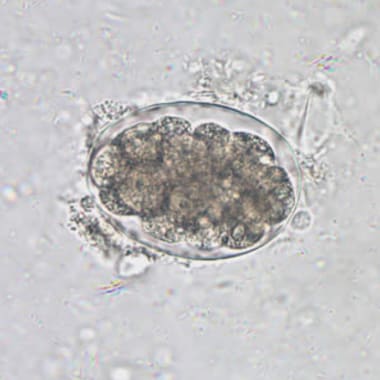Hookworm.
PKGhatak, MD.
The name Hookworm is given to this roundworm because the worm has anchoring teeth or hard plates in the mouth to latch onto the interstitial wall of its victims. An adult worm is 8 mm long and the female is 11 mm. The worms are round in shape, have a long thin unsegmented body with tapering ends, and are pale creamy color. Each worm carries both sex organs. The outer wall is made of a tough cuticle
Human diseases produced by hookworm:
Iron deficiency, anemia and protein malnutrition
Allergic skin lesions and eosinophilia. Cutaneous larva migrants
Eosinophilic enteritis.
The life cycle of hookworm.
Human excreta contaminates the soil, where hookworm infection is common. Children playing bare feet on the fields or farmers working on their fields, come in contact with the infective stage of hookworm larvae. It takes only 5 minutes for the larvae to find the tiny hair openings and or penetrate the skin. In the dermis, the larvae begin migrating to locate the capillaries or venules and enter. The blood carries the larvae to the right side of the heart and then into the pulmonary alveolar capillaries. This part of the migration takes 10 days. The larvae penetrate into the alveoli and enter the airways. Ultimately, the larvae enter into the major airways and are coughed up and swallowed. In the stomach, they are protected by the outer tough cuticle. Once inside the small intestine, the larva molts twice and develops a buccal capsule with teeth and a muscular esophagus. The larvae attach to the mucous membrane of the intestine from the lower duodenum and upper ileum. The larvae secrete tissue resolving enzymes which dissolve tissue and expose the blood vessels. The larvae bite and remain attached to the blood vessels of the intestine with their teeth or buccal plates. In humans, the parasites do not multiply.
The larvae quickly grow and attain maturity in a month and after mating, begin to release eggs. A female can release 30,000 eggs daily. Adult Nicator worm lives up to 5 years and Ancylostoma species for one year only.
In the soil.
The eggs release the immature Rhabdotiform larvae in a day or two. The larvae feed on the excreta and molt twice. In 7 days, rhabdotiform larvae become the infective Filariform larvae. The filariform larva has a short life outside and dies if unable to find a victim within 3 weeks.
;
Diagnosis:
The stool test for eggs is commonly done for the diagnosis of hookworm infection. The eggs with multiple larvae are diagnostic. Each egg measures 60 x 40 micrometers. The usual practice is to release the eggs from the fecal matter by placing a portion of the stool sample in a glass jar, diluting it with water and agitating it thoroughly. The eggs float on the top of the water and are collected by merely touching the top of the water with a glass slide.
PCR tests are available but are hardly utilized.
When the larvae are in migration and until the adult worm starts producing eggs, the stool tests will be negative. The PCR tests are needed for confirmation,
Treatment.
Albendazole is effective and requires a daily dose for 3 days or just one heavy dose.
Iron and vitamin supplements are also required.
Infection of hookworm does not provide protection from future infection. Vaccines are developed but not commercially available.
Epidemiology.
According to a 2010 WHO report, about 120 million people had hookworm infection. The countries where most cases are seen are poor - spanning from Sub-Saharan Africa to South Asia, East Asia and the Americas.
Species infective to humans.
Necator americanus infestation is the most common in humans, taking the world as a whole, followed by Ancylostoma duodenale.
Other hookworm species infective to humans are Ancylostoma ceylanicum,
Ancylostoma caninum
Ancylostoma braziliense.
A. barziliense commonly produce eosinophilia with creeping skin lesions called Cutaneous larva migrants.
Besides the common mode of infection, some species can infect humans via contaminated drinking water and breast milk in children. Ancylostoma craninum usually remains dormant in the skeletal muscles and produces eosinophilic dermatitis, bronchitis and asthma. Then move to the intestine to propagate.
Amount of blood loss and anemia.
It is reported that each adult Necator worm consumes 0.03 ml of blood and 0.2 ml of blood by Ancylostoma species. In addition, blood is also lost in the stool. On average, in a heavy infestation, humans lose 1 ml of blood per day per adult worm. In general, many dozens of worms live in the intestine at the same time. A heavy infestation is determined by the presence of over 4,000 eggs /gram of feces.
It does not take much time for the children to become severely anemic and the hemoglobin levels fall to 4 - 5 grams/dl.
An adult worm lives 1 to 5 years based on the species. An infestation of hookworm does not produce immunity against future infections.
Vaccines are known to protect against fresh infections in people, but are not utilized and not produced commercially.
**************************************

No comments:
Post a Comment